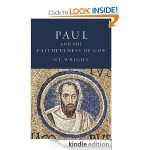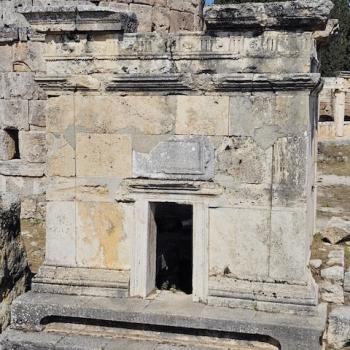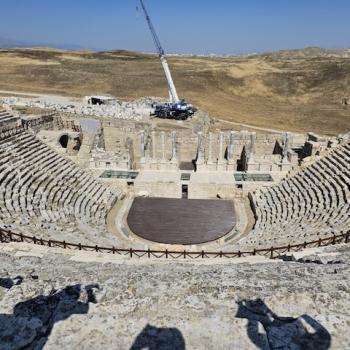In Chapter Seven, Tom takes on the pushback against narratival analysis of Paul’s letters. He does so not just because he knows that human beings make sense of what happens to them by telling stories, but because Bultmann was wrong. “The main problem with Bultmann’s [demythologizing] proposal, in addition to the muddling of the different senses of ‘myth’ [which does not necessarily refer to a fictional story], is that when he insisted that we should strip the early Christian world of its ‘mythology’ he meant not only that we should express the existential challenge of the Gospel without its pre-Enlightenment scientific assumptions but also that we should reconceptualize the Gospel in a non-narratival form, reducing it to the pure existential challenge of every moment, in which one is called to heart God’s word now rather than think in terms of the waste, sad time stretching before and after.” (p. 457). As Wright correctly shows, even Bultmann could not do without narrative in describing Paul’s Gospel, in fact he remythologized the Pauline Gospel.
[Here it is worth reminding that symbolic universe (the big taken for granted ideas like God) is being configured in stories, out of which Paul does his theologizing into specific situations. Paul’s ‘theology’ usually refers to our construal and combining and sorting and sifting of the theologizing we find Paul doing in his letters. See Witherington The Indelible Image, Vol. One and Two].
Wright goes on to point out that Bultmann’s new narrative of 1) humans unaware of the divine spark hidden in a clod of earth; 2) arrival of revelation or even the Revealer who raises a person’s consciousness; 3) the human goes on to live in tune with the inner divine spark abandoning the concerns of the clod of earth, is essentially a summary of gnosticism!! This is correct. Among other things it involves a radical deJudaizing of the story. Did Paul recast the message of the Gospel in non-Jewish forms? Tom says ‘me genoito!!’
On p. 460, Tom says it all boils down to this question– Were the early Christians aware that they were living within a narrative that was larger than that of their own sin,salvation, and spirituality, or not? Tom suggests that this question is really what the whole ‘New Perspective’ debate was all about— was the old Jewish story taken over, modified, or abandoned by Paul? Did he ditch everything about his previous worldview– symbols, stories, praxis and start afresh or not? Sometimes the term ‘apocalyptic’ is used to indicate the breaking or interrupting and rerouting of the old stories by means of heavenly invasion of a vision or a person etc. Tom wants to retain the word ‘apocalyptic’ as something radicalll new, but within the larger historical framework of Jewish narrative. [Side comment– this is where one can see the real debate between one narrative theologian like Wright and others such as myself. It leads to questions like— how new is the new covenant? How much discontinuity between the mosaic covenant and the new covenant? Is Paul mainly appropriating the story of Moses and Israel, or the earlier story of the patriarchs as the precursor to the story of Jesus?]
What Tom is guarding against is the Lou Martyn type use of the term apocalyptic to suggest radical discontinuity with the previous Jewish story.
Beginning on p. 462ff. Tom is going to push back against the push back by J.C. Beker and Francis Watson which suggests that Paul’s Gospel is not narratival in character, and does not amount to seeing the Gospel as the climax of Israel’s story or the story of salvation history etc. Tom admits that the story is not always on the surface of the letters, but the story in his view is fundamental and undergirds the whole. Worldview is what you look through, not at in his letters.
Tom explains the difference between poetic sequence– what the text says on the surface when it proceeds from one thing to the next, referential sequence– what the surface story or sequence is really about, what it is getting at, and worldview, which undergirds both of the other two. Now worldview can as easily be expressed in symbol and praxis as in story, so a focus on the Pauline narratives which are the basis for the theologizing and ethicizing into specific situations does not mean that symbols and praxis should be ignored. Indeed not. But notice for example with a praxis like the Lord’s Supper, it implies a story, as does baptism for that matter. Tom’s point is “without the story, we cannot be sure we have discerned the meaning of the symbolic praxis.” (p. 467).
As Tom goes on to say, much depends on what means by apocalyptic when it comes to Paul and his stories. If by apocalyptic, says Tom, one means something that enters the story unexpectedly and gives it a new direction, and sheds new light on the meaning of it all, or even brings the story to a climax, that is one thing. If one means by apocalytic something that brings the story telling to a halt altogether, like a fire alarm bell that goes off in the middle of a play, forcing an evacuation and no finish to the play, then that is quite another (see p. 473).
For the record it is worth pointing out that when Paul uses the term ‘mysterion’ he seems almost always to be talking about a surprising or unexpected ending or reversal of expectations at the end of the story: 1) for example the mysterion about the resurrection mentions in 1 Cor. 15, or 2) the mysterion about what will happen with Israel and the Gentiles (the order in which they come into the eschatological people of God), and when all Israel will be saved; or 3) the marriage of Christ and his church and when that will transpire. In other words, it seems clear enough that when Paul begins to talk about apocalytic secrets, it does indeed have to do with the main story, indeed to do with the climax or end of the main story he has been telling all along.
Tom thinks in terms of five stories that are crucial to understanding Paul, and he stresses that these narratives shed fresh light on the exegesis of many passages. The Outer Story as he calls it is about God and creation, but in fact it is also about the Fall or else there would be no story. God created the universe is not a story any more than the cat sat on the mat. It is when a sin, a fall enters the creation story that we begin to have a plot, not just an announcement of an accomplishment. There is now a present evil age and Jesus must intercede and bring in the age to come and with it a new creation for the original design and story to be properly fulfilled. One is rescued out of the evil age, but not out of the world. This is not a Gnostic story about matter being evil and spirit good. It’s about redemption of creature and creation. (see pp. 476-79). Through the death and res. of Jesus the old fallen order indeed the fallen world has been crucified, the form of the old world is thus passing away and the new has broken into the midst of the increasingly obsolete old.













